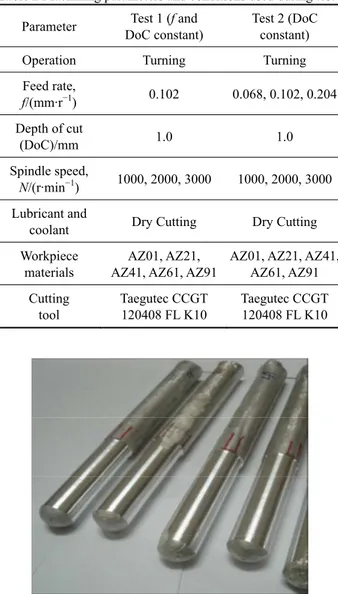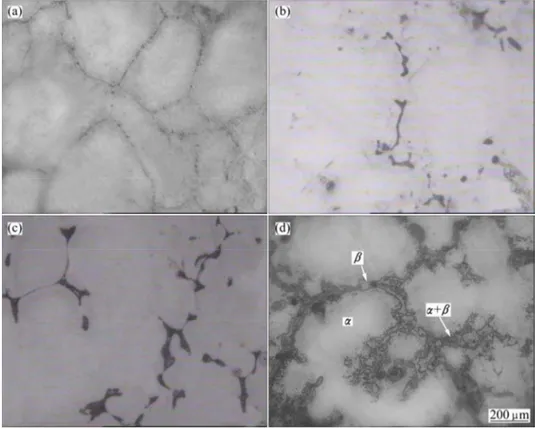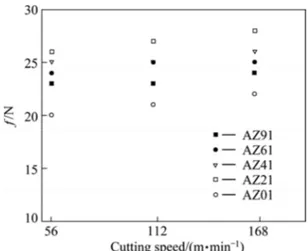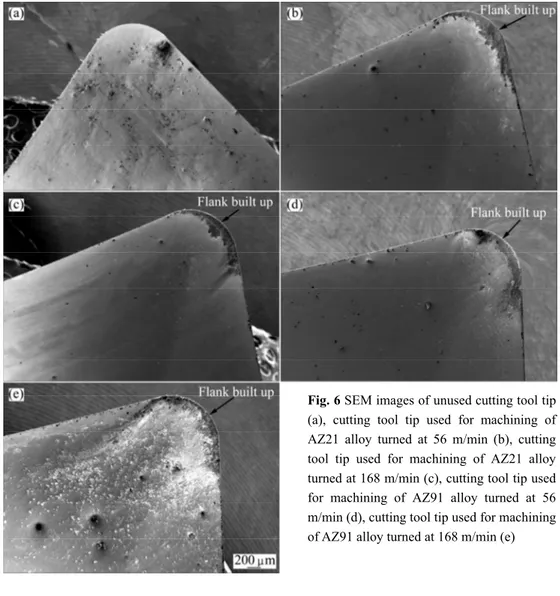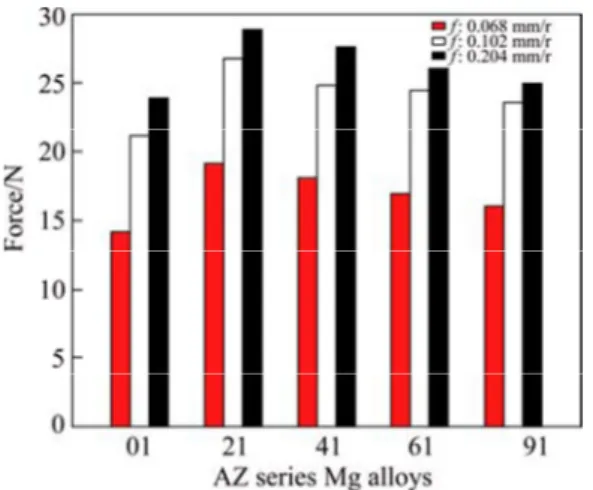Trans. Nonferrous Met. Soc. China 23(2013) 2243−2249
Influence of Al content on machinability of AZ series Mg alloys
Birol AKYUZDepartment of Mechanical and Manufacturing Engineering, Bilecik Seyh Edebali University, Bilecik 11200, Turkey Received 24 August 2012; accepted 4 February 2013
Abstract: Influence of Al content on the machinability of AZ series cast Mg alloys was investigated. In order to evaluate the
machinability of the alloys, measurements of the cutting forces during turning operations and surface roughness were carried out as well as considering the microstructure and tensile properties. The results show that maximum tensile properties are observed with 2% (mass fraction) Al addition to Mg. As the Al content of the alloy increases above 2%, the cutting forces tend to reduce along with the ductility owing to the grain boundary precipitation of intermetallic phase (β-Mg17Al12). Cutting forces are able to increase as the
cutting speed increases for all the alloys studied, and it’s attributed to flank built up at the tip of the cutting tool during machining.
Key words: machinability; cutting force; Mg; AZ series alloys
1 Introduction
Mg alloy with a nominal density of around 1.74 g/cm3 is one of the lightest structural metals, which has
excellent mechanical properties, such as high specific strength and high specific stiffness. Due to the low density, it is used in many applications including telecommunication, automotive, portable microelectronics, materials-handling and aerospace industries [1]. In automotive industry, the utilization of Mg alloys as automotive components is a main concern to reduce fuel consumption and associated reductions in vehicle mass leading to reduced discharge of air pollutants such as SOx, CO2, and NOx emissions.
In manufacturing industry, the most widely used Mg alloys may be classified as AM (Al, Mn), AZ (Al, Zn), and AS (Al, Si) series Mg alloys [2]. Mg parts are generally produced by casting processes [3] owing to the hexagonal lattice structure which makes it difficult to forge and mill. Thus, machining of functional cast part is usually necessary. It is possible to achieve a high machining speed (cutting speed) for Mg alloys, however, there are concerns that with an increase in cutting speed, there may be serious flank build-up (FBU) due to adhesion between the cutting tool and the workpiece [4] as well as ignition problems [5].
FRIEMUTH and WINKLER [6] reported chip temperature and the danger of chip ignition. They
reported that when using polycrystalline diamond tools, low machining forces could be reduced in dry condition machining of Mg alloys. FANG et al [7] presented an experimental study of the mean temperature on the flank face for predicting the occurrence of ignition in high speed cutting of Mg alloys. OZSVÁTH et al [8] used a new thermo-vision method to examine the chip temperature on rotating milling tool. ARAI et al [9] proposed a method of the chip control by skiving of Mg alloys and investigated cutting conditions experimentally for generating tubular helical chips, which were not ignited easily.
FBU may cause machining problems related to vibration and tolerances as well as the thermal expansion of Mg, which may lead to variations in accuracy and geometrical shape of the machined part [5]. TÖNSHOFF et al [10,11] carried out turning experiments on the AZ91HP alloy. They observed that FBU due to adhesion between cutting tool and workpiece could occur at cutting speed of 900 m/min when machining Mg in dry condition. TOMAC et al [12] also studied the machinability of Mg alloys as a function of Al content by comparing AZ and AS series. However, the comparison may be arguable since they have different microstructures. For example, AS series Mg alloys contain Si and therefore hard Mg2Si intermetallic phases
[13,14] whereas AZ series Mg alloys contain Mg17Al12
intermetallic phases in their microstructure. Therefore, different microstructure should vary cutting forces
Corresponding author: Birol AKYUZ; Tel: +90-228-2141542; Fax: +90-228-2141222; E-mail: birol.akyuz@bilecik.edu.tr
during machining.
In the literature, the effect of Al content on the machinability of AZ series Mg alloys is scarce [12]. Thus, the aim of this work is to investigate the effect of Al alloying additions (0 to 9% Al) to AZ series Mg alloys on their machinability as well as mechanical properties.
2 Experimental
The compositions of the cast AZ series Mg alloys utilized in the present study are listed in Table 1. Details of the casting operations are well described by UNAL [15] and CANDAN et al [16,17]. After the casting process characterization of the alloys was made by microscopic examinations and tensile tests. Microstructural surveys were conducted on the metallographic samples by a Nikon Eclipse LV150 type optical microscope after etching with 1 mL HNO3, 24
mL and 75 mL ethylene glycol solution. The tensile tests were performed at room temperature according to the ASTM E 8M-99 standard with a crosshead speed of 0.8 mm/min (Shimadzu Autograph AGS-J 10 kN Universal Tester) on tensile test samples which have gage diameter and length of 8 mm and 40 mm, respectively. The averages of minimum three samples were taken in to account in the determination of tensile values.
Table 1 Chemical composition of AZ series Mg alloys (mass
fraction, %) Alloys Al Mn Zn Si Fe Mg AZ01 0.4 0.12 1.22 0.13 0.024 Rest AZ21 1.9 0.13 1.30 0.08 0.026 Rest AZ41 4.31 0.11 1.11 0.09 0.025 Rest AZ61 6.53 0.15 0.93 0.11 0.028 Rest AZ91 9.5 0.11 0.96 0.12 0.022 Rest
Machining tests were conducted by using a 2.2 kW Boxford 250 CNC lathe machine to determine the cutting forces under dry cutting conditions. Polycrystalline diamonds (PCD) (Taegutec CCGT 120408 FL K10) were used as cutting tools in the turning operations. Cutting force curves were obtained by creating a mechanism with the help of strain gauge as shown in Fig. 1. Two types of experimental work have been carried out for evaluation of cutting forces. One was that feed rate (f) and depth of cut (DoC) were kept constant to maintain cross-sectional area of the chips in per revelation, while the other type was on the basis of constant f of cutting tool at varied revelations and DoC’s. The machining parameters and conditions in the experiment are given in Table 2. The cast samples were subjected to pre-cleaning operation (i.e. diameter reduced from 25 to 20 mm) before the experiments as shown in Fig. 2. Surface
roughness measurements were carried out after the each turning test. Scanning electron microscopy (SEM) examinations were also carried out to evaluate FBU on the surfaces of the cutting tools.
Fig. 1 Schematic representation of experimental set-up with
strain gauge
Table 2 Machining parameters and conditions used during test
Parameter DoC constant) Test 1 (f and Test 2 (DoC constant)
Operation Turning Turning Feed rate, f/(mm·r−1) 0.102 0.068, 0.102, 0.204 Depth of cut (DoC)/mm 1.0 1.0 Spindle speed, N/(r·min−1) 1000, 2000, 3000 1000, 2000, 3000 Lubricant and
coolant Dry Cutting Dry Cutting Workpiece
materials
AZ01, AZ21, AZ41, AZ61, AZ91
AZ01, AZ21, AZ41, AZ61, AZ91 Cutting tool Taegutec CCGT 120408 FL K10 Taegutec CCGT 120408 FL K10
Fig. 2 Test samples of AZ series Mg alloys
3 Results and discussion
3.1 Microstructure
alloys. It was noted that a dark colored β phase network tended to surround the α-Mg grains of the matrix with increasing Al content of the alloy. Published literatures [18−21] revealed that commonly known primary α-Mg, intermetallic β-Mg17Al12 and α+β eutectic phases were
present in AZ series alloys in accordance with the present work. It was reported that the formation of β-phase was due to changes in the solidification behaviour of the melt by Zn addition [17,19].
3.2 Tensile properties
Figure 4 shows the dependence of the ultimate tensile strength (UTS), yield strength (YS) and elongation (EL) of the alloys studied on the Al content,
respectively. Evidently, 2% Al addition increased UTS and YS considerably (Fig. 4(a)). It should be noted that around 50% increase has been obtained both in UTS (from 135 to ~203 MPa) and YS (from 65 to ~96 MPa) by 2% Al addition to Mg. Further Al additions (up to 6.5%) did not cause a remarkable change in both UTS and YS. Among the examined alloys, the lowest UTS and YS values obtained in 9.5% Al containing alloy. On the other hand, elongation continuously decreased above 2% Al content.
CANDAN et al [17] has reported that the presence of net-like intermetallics means that there is a continuous easy crack path of brittle phase along the α-Mg grain boundary. Thus, low ductility should be expected
Fig. 3 Optical micrographs of AZ21 (a), AZ41 (b), AZ61 (c) and AZ91 (d) series Mg alloys
because the net-like brittle intermetallic phases at the α-Mg grain boundary easily breaks up and causes cracking during plastic deformation. Indeed, UTS and elongation of AZ91 alloy exhibited ~167 MPa and ~2.6% respectively, yielding the lowest mechanical properties as compared to AZ21, AZ41 and AZ61 alloys. The results of this work are reasonably in accordance with the work of ZHAO et al [20] who reported 126 MPa UTS and 3.3% elongation for AZ91 alloy and WU et al [21] who reported 145 MPa UTS and 1.5% elongation. Deviations from the reported results [20,21] are probably due to the production conditions such as impurity of the alloy, casting temperature and solidification condition. The increased UTS and YS of AZ21 alloy were believed to be due to the reduction of brittle β phases around grain boundaries and solid solution strengthening. Diminishing of β phases at the interface should eliminate uneven crack initiation sites during tensile tests. Scattering in elongation was considerably reduced in AZ21 alloy as compared to AZ91 alloy supporting the argument above (Fig. 4(b)).
3.3 Machining
Figure 5 shows the effect of cutting speed variations on the cutting force for the five machined samples as a function of the Al content. Although the constant cross sectional areas of the chips are maintained, these curves are seen to increase slightly as the cutting speed increases for all the alloys studied. This is attributed to FBU at the tip of the cutting tool during machining. Fig. 6 shows SEM images of cutting tool tips that are used for machining of AZ21 and AZ91 alloys turned at 56 and 168 m/min. Evidently, FBU is present on the surfaces of the cutting tools. FRIEMUTH and WINKLER [6] reported that FBU was a characteristic feature in machining Al-containing Mg alloys having Mg17Al12 eutectic phase at grain boundaries. However,
the present work shows that the FBU is also observed in the AZ21 alloy which has no or limited Mg17Al12 eutectic
phases in its microstructure (Fig. 3(a)). The main reason of FBU for these alloys has proved to be the local rise in temperature up to which the eutectic melt (437 °C for Mg−Al alloy) and/or chips ignite. It is well known that Mg chips ignite [6] or oxidize easily depending on cutting condition. MgO (sparked or ignited chips) generally forms as powder during cutting. The presence of FBU on the tool causes rubbing with the machined part and consequently increases the cutting force. TOMAC et al [12] reported that when certain Mg alloys were cutting at high cutting speeds without the cutting fluid, FBU formed on the flank surfaces of the tool. Their number of turning tests have shown that FBU may be formed during machining certain Mg alloys when the
cutting speed exceeds a critical limit leading to increase cutting force in accordance with the present work.
Fig. 5 Relationship between cutting forces and alloy
compositions of AZ series Mg alloys (DoC: 1 mm, f: 0.102 mm/r)
For AZ01 control sample, the cutting force was around 19.5 N (turned at 56 m/min) which was the lowest cutting force among the alloys studied. This is due to the lower mechanical properties of Mg as well as its brittle properties. The UTS and elongation of AZ01 alloy are around 135 MPa and 2.5% respectively as shown in Fig. 4(a) and (b). Comparing Al-containing alloys, the cutting force is much lower for the AZ91 alloy than for the AZ21 alloy. This is also attributed to their mechanical properties. For example, the UTS of AZ21 and AZ91 alloys are 203 and 167 MPa and their elongation are 3.5% and 2.6%, respectively (Figs. 4(a) and (b)). The results of the cutting force are also in line with Figs. 4(a) and (b). Mechanical properties such as UTS, YS and elongation, are at the highest value for AZ21 alloy, which is due to solute solution effect as mentioned in tensile properties section earlier. As Al content of the alloys increases above 2.0%, the cutting force is decreased (Fig. 5). This is probably due to the presence of brittle intermetallic Mg17Al12 phases
generally located at the grain boundaries of Mg matrix phase as shown in Fig. 3(d). Since the amount of Mg17Al12 phase is the highest in AZ91 alloy, lower
cutting force is observed among Al-containing alloys. This indicates that Mg17Al12 phase results in easy
removal of the chips by accelerating fracture during turning operation (Fig. 5).
Figure 7 depicts the surface roughness (Ra) of the
samples, turned at 56, 112 and 168 m/min, indicating that the Ra with increasing cutting speed for all the alloys
studied. The improvement Ra with the augmentation of
cutting speed is an expected feature for improving the surface quality and is a widespread method. The present work shows that Al content of the Mg alloys affects the
Fig. 7 Relationship between surface roughness and cutting
speeds of AZ series Mg alloys (DoC:1 mm)
Ra considerably. In other words, Ra value decreases as the
Al content of the alloys increases. For instance, turning of AZ21 and AZ91 alloys at 168 m/min presents Ra
values as 1.25 and 1.18 µm, respectively. The trends in Ra at other cutting speeds are also similar as depicted in
Fig. 7. The higher Ra value for AZ21 alloy is believed to
be due to dimples occuring during shearing of the chip removal. The dimples can become elongated by a lateral shearing force in ductile materials. Indeed, AZ21 alloy has the highest ductility as compared to the other alloys studied as shown in Fig. 4(b). Increasing Al content of the alloy decreases the elongation of the samples, implying that the materials become brittle. As discussed in tensile properties section, the net-like brittle intermetallic phases at the α-Mg grain boundary easily breaks up and causes cracking during plastic deformation, leading to a brittle shear. However, the slight increase in Ra value in AZ91 alloy may be due to high amount of
brittle Mg17Al12 eutectic phases along the grain
boundaries. It is postulated that the shear during cutting may follow the grain boundaries due to net-like interconnected Mg17Al12 phases resulting in rougher
surface. This also is in lane with the tensile properties in Fig. 4 that the scatterings are more pronounced in AZ91 alloy.
Figure 8 shows the cutting forces for the alloys studied under varied feed rates. As expected, the cutting force is increased as the feed rate increases. This is
Fig. 6 SEM images of unused cutting tool tip
(a), cutting tool tip used for machining of AZ21 alloy turned at 56 m/min (b), cutting tool tip used for machining of AZ21 alloy turned at 168 m/min (c), cutting tool tip used for machining of AZ91 alloy turned at 56 m/min (d), cutting tool tip used for machining of AZ91 alloy turned at 168 m/min (e)
attributed to the increased cross sectional area of the chips at per revolution. It should be noted that the highest cutting force is present for AZ21 alloys whereas the lowest cutting force is obtained for AZ91 amongst Al- containing alloys (except AZ01 which contains negligible Al) at all feed rates studied. Higher cutting forces for AZ21 alloy is believed to be due to higher mechanical properties as discussed earlier in tensile properties section and indeed, the tendency is very similar to tensile strengths of the alloys studied (Fig. 4(a)).
Fig. 8 Cutting forces of AZ series Mg alloys under various feed
rates (DoC:1 mm)
4 Conclusions
1) Network of the β-phase around the grain boundaries is formed and the amount of intermetallic β-phase increases with increasing Al content in Mg alloys.
2) UTS and YS increase with the addition of Al to Mg. Maximum UTS, YS and elongation are observed at AZ21 alloy, which is attributed to the solute solution strengthening of the Mg alloy. The decreases in UTS, YS and elongation values above 2% Al additions are attributed to formation of net-like brittle intemetallic phases.
3) The cutting forces are seen to increase as the cutting speed increases for all the alloys studied which is attributed to FBU at the tip of the cutting tool during machining. As compared to Al-containing alloys, the cutting force was much lower for the AZ91 alloy than for the AZ21 alloy, which was due to the formation of continuous net-like brittle β-phase around the grain boundaries.
4) Roughness of the samples decreases with increasing cutting speed for all the alloys studied. As Al content of the alloys increases, roughness value decreases considerably.
Acknowledgements
The author would like to thank to Prof. Sennur CANDAN and Prof. Ercan CANDAN for discussion and support.
References
[1] FRIEDRICH H E, MORDIKE B L. Magnesium technology metallurgy, design data, applications [D]. Springer, 2006.
[2] KING J F. Development of practical high temperature magnesium casting alloys, magnesium alloys and their applications [M]. Weinheim: WILEY-VCH, 2000: 14−22.
[3] KING J F. Technology of magnesium and magnesium alloys, magnesium technology [M]. Verlag Berlin Heidelberg: Springer, 2006.
[4] TÖNSHOFF H K, DENKENA B, WINKLE R J, PODOLSKY C. Machining, magnesium technology, metallurgy, design data, applications [M]. Verlag Berlin Heidelberg: Springer, 2006, 398. [5] HOU J, ZHOU W, ZHAO N. Methods for prevention of ignition
during machining of magnesium alloys [J]. Key Engineering Materials, 2010, 447−448: 150−154.
[6] FRIEMUTH T, WINKLER J. Machining of magnesium workpieces [J]. Advanced Engineering Materials, 1999, 1(3−4): 183−186. [7] FANG F Z, LEE L C, LIU X D. Mean flank temperature
measurement in high speed dry cutting of magnesium alloy [J]. Journal of Materials Processing Technology, 2005, 167: 119–123. [8] OZSVÁTH P, SZMEJKÁL A, TAKÁCS J. Dry milling of
magnesium based hybrid Materials, Transportation Engineering, 2008, 36(1−2): 73−78.
[9] ARAI M, SATO S, OGAWA M, Shikata H I. Chip control in finish cutting of magnesium alloy [J]. Journal of Materials Processing Technology, 1996, 62: 341–344.
[10] TÖNSHOFF H K, WINKLER J. The influence of tool cutting in machining of magnesium [J]. Surface and coating Technology, 1997, 94−95: 610−616.
[11] TÖNSHOFF H K, FRIEMUTH T, WINKLER J, PODOLSKY C. Improving the characteristics of magnesium workpieces by burnishing operations [M]. Magnesium Alloys and their Applications, Weinheim: WILEY-VCH Verlag GmbH, 2006: 406.
[12] TOMAC N, TØNNESEN K, MIKAC T. Study of influence of aluminum content on machinability of magnesium alloys [J]. Strojarstvo, 2008, 50(6): 363–367.
[13] BRONFIN B, KATSIR M, AGHION E. Preparation and solidification features of AS21 magnesium alloy [J]. Materials Science and Engineering A, 2001, 302(1): 46−50.
[14] KIM B H, LEE S W, PARK Y H, PARK I M. The microstructure, tensile properties, and creep behavior of AZ91, AS52 and TAS652 alloy [J]. Journal of Alloys and Compounds, 2010, 493: 502–506. [15] UNAL M. An investigation of casting properties of magnesium
alloys [D]. Ankara: Gazi University, Institute of Science and Technology, 2008.
[16] CANDAN S, UNAL M, TURKMEN M, KOC E, TUREN Y, CANDAN E. Improvement of mechanical and corrosion properties of magnesium alloy by lead addition [J]. Materials Science and Engineering A, 2009, 501: 115−118.
[17] CANDAN S, UNAL M, KOC E, TUREN Y, CANDAN E. Effects of titanium addition on mechanical and corrosion behaviours of AZ91 magnesium alloy [J]. Journal of Alloys and Compounds, 2011, 509: 1958−1963.
[18] LIU S, ZHANG Y, HAN H. Role of manganese on the grain refining efficiency of AZ91D magnesium alloy refined by Al4C3 [J]. Journal of Alloys and Compounds, 2010, 491: 325–329.
S, PAI B C. Effect of intermetallic phases on the creep behavior of AZ91 magnesium alloy [J]. Materials Science and Engineering A, 2010, 527: 1395–1403.
[20] ZHAO M C, DENG Y L, ZHANG X M. Strengthening and improvement of ductility without loss of corrosion performance in a magnesium alloy by homogenizing annealing [J]. Scripta Materialia, 2008, 58: 560−563.
[21] WU G, FAN Y, GAO H, ZHAI C, ZHU Y P. The effect of Ca and rare earth elements on the microstructure, mechanical properties and corrosion behavior of AZ91D [J]. Materials Science and Engineering A, 2005, 408: 255−263.
[22] LIU K, LI X P, LIANG S Y. The mechanism of ductile chip formation in cutting of brittle materials [J]. Int J Adv Manuf Technology, 2007, 33: 875−884.
铝含量对
AZ 系列镁合金机械加工性能的影响
Birol AKYUZ
Department of Mechanical and Manufacturing Engineering, Bilecik Seyh Edebali University, Bilecik 11200, Turkey
摘 要:研究铝含量对AZ 系列铸造铝合金机械加工性能的影响。为评价该合金的机械加工性能,测量切削操作
过程中的切削力以及表面粗糙度,以及研究显微组织和拉伸性能。结果表明:添加2% 铝含量的镁合金具有最佳
的拉伸性能。随着铝含量增加到2%以上,由于晶界上析出金属间化合物 β-Mg17Al12,切削力会随延展性的降低
而降低。切削力也会随着切削速度的增加而增大,这是由于在加工过程中切削工具的尖端有侧面生成。
关键词:切削性能;切削力;Mg;AZ 系列合金
